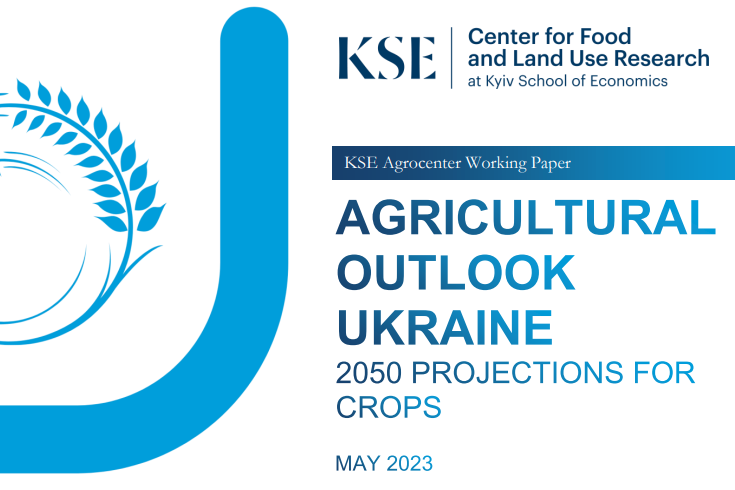Agricultural Outlook Ukraine May 2023
The current Agricultural Outlook issues present the long-term projections of the crop markets development in Ukraine, i.e., until 2050 as well as the 2022 situation and projects the markets development for 2023 and beyond assuming the 2023 status quo.
Download in Engels: '2050 Projections for Crops'
Download in Engels: '2030 - Cereals and Oilseeds market projections'

2050 - Projections for Crops
The world is looking ahead concerned with climate change and “greening” policies that challenge the conventional way of farming, with growing population and the increase in food demand and changing consumer preferences towards plant based diet. With Ukraine fighting for life in the unprecedented attack onto its independence by RF, it is important to locate the expectations about its crop production on the map of global food supply and trade. The country is one of the leading wheat, corn, barley and sunflower seed commodities exporter in the world. In the last decade it supplied around 10% of the world wheat, 15% of corn and barley and more than 50% of the sunflower oil exports.
Conclusions:
As the RF’s war in Ukraine goes on, the Ukraine’s agricultural sector loses the resources for recovery. The financial and labor inputs are already stretched in 2023. According to the modelling results, some of the sectors will not reach the pre war levels even after seven years of peace. With the market forces only, sunflower, barley and wheat sectors are expected to recover by 2040. By 2050, under the current world market trends and the destruction level brought by the war, maize, rye, oats and rapeseed sectors are expected to recover, wheat, barley and sunflower are expected to grow, whereas soya production seem to drop tremendously. This means that it may take as long as 20 years for Ukraine to regain its strength in agriculture after the devastation brought by the Russian military assault.
Visit https://kse.ua/agricultural-outlook/ for this and more reports

2023 - cereals and oilseeds market projections
The RF`s full-scale military invasion of Ukraine has lasted for almost 1.5 years now. It has devastating impacts on the people’s lives, economies and food security around the globe. Food commodities prices are still very high: “the FAO Food Price Index, which tracks monthly changes in the international prices of commonly-traded food commodities, averaged 127.2 points in April 2023, up 0.6 percent from March. At that level, the Index was 19.7 percent below its level in April 2022, but still 5.2 percent higher than in April 2021”, with many countries facing high food prices inflation “high [food price – from the authors] inflation in almost all low- and middle-income countries, with inflation levels above 5 percent in 94.1 percent of low-income countries, 86 percent of lower-middle-income countries, and 93.0 percent of upper-middle-income countries and many [countries – from the authors] experiencing double-digit inflation. In addition, 87.3 percent of high-income countries are experiencing high food prices inflation. The most affected countries are in Africa, North America, Latin America, South Asia, Europe, and Central Asia. In real terms, food price inflation exceeded overall inflation (measured as year-on-year change in the overall CPI) in 88.8 percent of the 160 countries for which food CPI and overall CPI indexes are both available”. As of the end of 2022, however, IFPRI states that the major food crisis has been averted due to the Black Sea Grain Initiative, an increase in global humanitarian efforts to mitigate the impacts of the war and record wheat harvests in Canada, the European Union, and Russia. With the world tackling the crisis with production growth in other regions and export initiative in Ukraine, the future for Ukrainian agriculture looks less and less pretty the longer the war lasts. According to the production experts and the producers themselves, whereas the 2022 sowing season took place with the resources accumulated in 2021, the 2023 and the following production seasons have considerably fewer means.
As the RF’s war in Ukraine goes on, the Ukraine’s agricultural sector loses the resources for recovery. The financial and labor inputs are already stretched in 2023. According to the modelling results, some of the sectors will not reach the pre war levels even after seven years of peace. In this war Ukraine stands its dignity and the freedom of choice, and it seems that the people including the farmers will rather lose everything than give in to the RF’s regime. Therefore, the sooner the victory of Ukraine over the aggressive totalitarian regime comes, the more chances the Ukrainian agricultural sector will have to recover. It is important to note, however, that this analysis does not include any support for the sector. If it was hypothesized, the projection results could have been different.
Visit https://kse.ua/agricultural-outlook/ for this and more reports